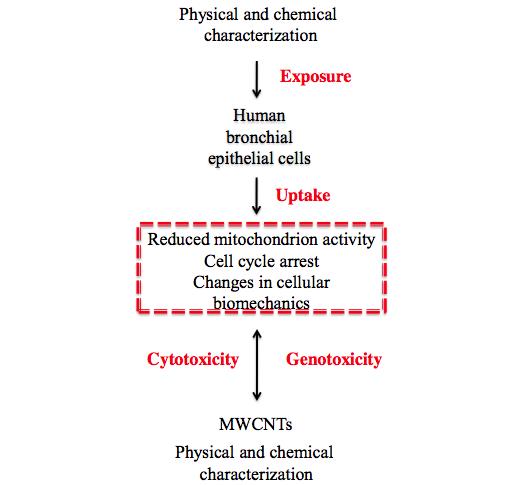 You may have heard of a material called asbestos. Asbestos was used as a construction material in the 19th and 20th centuries until it became the pivot of a widely-spread health concern in the 1980s and 1990s. The fibers’ long aspect ratio and crystalline makeup can cause serious respiratory illnesses, including lung cancer. This health hazard drove a ban on asbestos products.
You may have heard of a material called asbestos. Asbestos was used as a construction material in the 19th and 20th centuries until it became the pivot of a widely-spread health concern in the 1980s and 1990s. The fibers’ long aspect ratio and crystalline makeup can cause serious respiratory illnesses, including lung cancer. This health hazard drove a ban on asbestos products.
Carbon nanotubes (CNTs) also have a high aspect ratio—they are very long and thin, and their atoms are also very neatly arranged in a crystal structure. So it is fair to assume that, if inhaled, CNTs may deposit on the respiratory system and cause a health risk similar to that of asbestos.
Currently there are multiple research efforts aiming at understanding the potential inhalation toxicity of CNTs. One complicated issue of this type of research is being able to discern the toxic effect caused by the CNT and the metal catalysts that are usually present. These metal catalysis are used to help synthesize CNTs and left at the tips of the tubes. The recently published work of Cerasela Zoica Dinu and colleagues examines the toxicity of CNTs that had been stripped clean of their metal catalysts.
Another very complicating factor of examining the inhalation toxicity to nanomaterials in general—but especially fibers—is exposing lung cell cultures to nanomaterials in the same way that our lung cells would be exposed to these very nanomaterials, in air. While this work didn’t use the air route to expose the lung cells to CNTs, they were able to find interesting results. Their research takes us one step closer to understanding how CNTs interact with human cells, cause changes in multiple cellular processes to result in various degrees of toxicity.
To access the full article, download a copy for free* by clicking the link below.
Towards Elucidating the Effects of Purified MWCNTs on Human Lung Epithelial cells
DOI: 10.1039/C4EN00102H
Chenbo Dong et al.
Liked this blog? Find out more about Marina in her first Environmental Science Nano blog on carbon nanotubes.
* Access is free through a registered RSC account – click here to register










